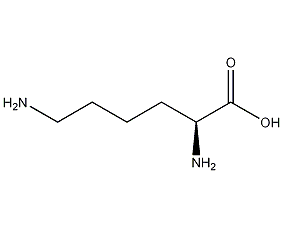
Structural formula
| Business number | 0181 |
|---|---|
| Molecular formula | C6H14N2O2 |
| Molecular weight | 146.19 |
| label |
(S)-2,6-diaminocaproic acid, (S)-2,6-Diaminocaproic acid, (S)-(+)-Lysine, amino acid drugs, intermediates, Biochemical reagents |
Numbering system
CAS number:56-87-1
MDL number:MFCD00064433
EINECS number:200-294-2
RTECS number:OL5540000
BRN number:1722531
PubChem number:24896404
Physical property data
1. Properties: Colorless needle-like crystals or crystalline powder. Optically active.
2. Density (g/mL, 25/4℃): 1.125
3. Relative vapor density (g/mL, air=1): Undetermined
4. Melting point (ºC): It turns black when heated to 210℃ and decomposes at 224.5℃.
5. Boiling point (ºC, normal pressure): Undetermined
6. Boiling point (ºC, 5.2kPa): Undetermined
7. Refractive index: Undetermined
8. Flash point (ºC): Undetermined
9. Specific rotation (º): α]D20 +14.6° (C=6.5, in water), [ α]D23+25.9° (C=2, in 6mol/L hydrochloric acid)
10. Autoignition point or ignition temperature (ºC): Undetermined
11. Vapor pressure ( kPa, 25ºC): Undetermined
12. Saturated vapor pressure (kPa, 60ºC): Undetermined
13. Heat of combustion (KJ/mol): Undetermined
14. Critical temperature (ºC): Undetermined
15. Critical pressure (KPa): Undetermined
16. Oil-water (octanol/water) partition coefficient pair Value: Undetermined
17. Explosion upper limit (%, V/V): Undetermined
18. Explosion lower limit (%, V/V): Undetermined
19. Solubility: hygroscopic. Very soluble in water, slightly soluble in ethanol, almost insoluble in ether.
Toxicological data
1. Reproductive toxicity: Oral TDLo of female rats: 138mg/kg, conception takes 5-15 days; Oral TDLo of female rats: 72450mg/kg, conception takes 10-20 days; Oral TDLo of female rats: 90450mg/kg, Conception occurs after 10-20 days; oral TDLo in female rats: 81 mg/kg, conception occurs after 10-20 days; intraperitoneal TDLo in female rats: 44 mg/kg, conception occurs after 5-15 days 2. Mutagenicity: sister chromatid exchangeTEST system : Human lymphocytes: <SPAN lang=E BODY
Ecological data
None yet
Molecular structure data
1. Molar refractive index: 38.43
2. Molar volume (cm3/mol): 129.9
3. Isotonic specific volume (90.2K ): 348.1
4. Surface tension (dyne/cm): 51.5
5. Polarizability (10-24cm3): 15.23
Calculate chemical data
1. Reference value for hydrophobic parameter calculation (XlogP): None
2. Number of hydrogen bond donors: 3
3. Number of hydrogen bond acceptors: 4
4. Number of rotatable chemical bonds: 5
5. Number of tautomers: none
6. Topological molecule polar surface area 89.3
7. Number of heavy atoms: 10
8. Surface charge: 0
9. Complexity: 106
10. Number of isotope atoms: 0
11. Determine the number of atomic stereocenters: 1
12. Uncertain number of atomic stereocenters: 0
13. Determine the number of chemical bond stereocenters: 0
14. Number of uncertain chemical bond stereocenters: 0
15. Number of covalent bond units: 1
Properties and stability
1. Found in tobacco leaves.
Storage method
This product should be sealed and stored dry and below 0℃.
Synthesis method
1. L-lysine is generally supplied to the market as L-lysine hydrochloride [657-27-2]. Free L-lysine is easily deliquesced and prone to yellowing and deterioration due to its free amino groups. , and has a pungent fishy smell, making it difficult to store for a long time. L-lysine hydrochloride is relatively stable, not easy to deliquesce, and easy to store. However, the demand for L-lysine in some uses is also increasing, such as peptide synthesis chemistry, biochemical research, and preparation of lysine derivatives. Free L-lysine can be prepared from L-lysine hydrochloride.
2. Tobacco: BU, 22; FC, 21; can be obtained by hydrolysis and refining of animal protein. It can also be synthesized from benzoyl piperidine.
Purpose
For biochemical research. Medium preparation.

 微信扫一扫打赏
微信扫一扫打赏

